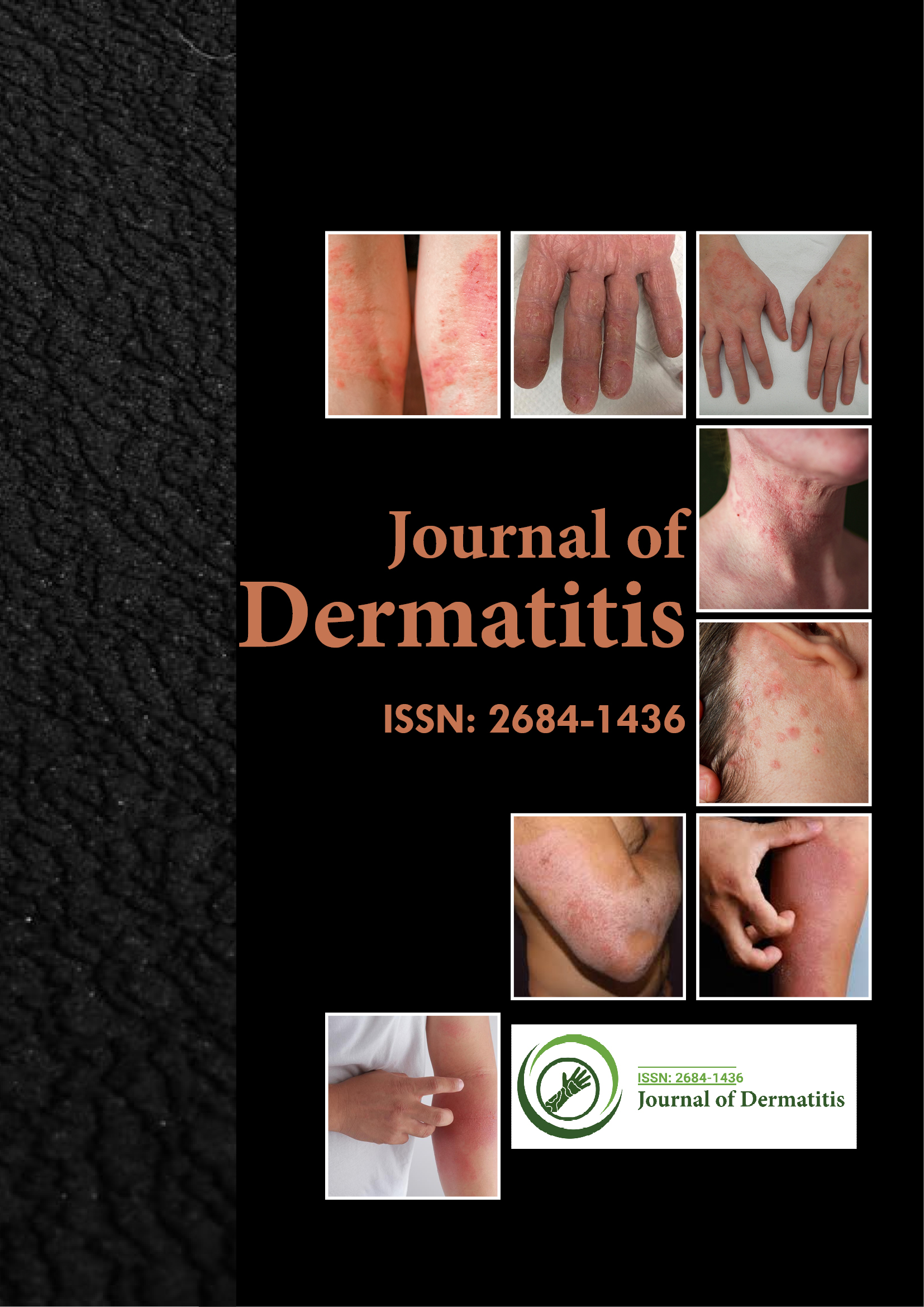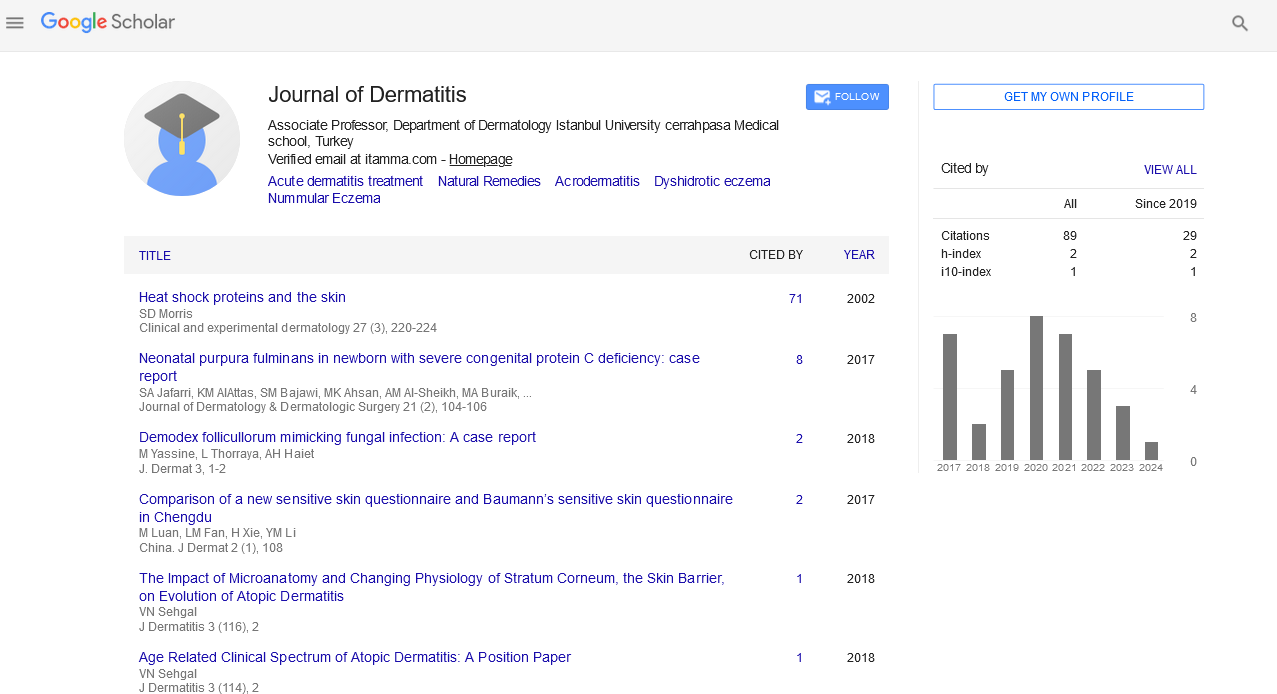Indexed In
- RefSeek
- Hamdard University
- EBSCO A-Z
- Euro Pub
- Google Scholar
Useful Links
Share This Page
Journal Flyer

Open Access Journals
- Agri and Aquaculture
- Biochemistry
- Bioinformatics & Systems Biology
- Business & Management
- Chemistry
- Clinical Sciences
- Engineering
- Food & Nutrition
- General Science
- Genetics & Molecular Biology
- Immunology & Microbiology
- Medical Sciences
- Neuroscience & Psychology
- Nursing & Health Care
- Pharmaceutical Sciences
Perspective - (2022) Volume 7, Issue 4
Signs and Symptoms of Alopecia Areata
Evan Darwin*Received: 01-Jul-2022, Manuscript No. JOD-22-17657; Editor assigned: 04-Jul-2022, Pre QC No. JOD-22-17657 (PQ); Reviewed: 18-Jul-2022, QC No. JOD-22-17657; Revised: 25-Jul-2022, Manuscript No. JOD-22-17657(R); Published: 01-Aug-2022, DOI: 10.35248/2684-1436.22.7.159
Description
Alopecia areata is a recurrent, non-scarring form of hair loss that can appear in a variety of patterns and can affect any area of the body that bears hair. Despite being a benign condition with few symptoms in the majority of patients, it can still lead to emotional and psychosocial distress.
Signs and symptoms
The majority of people with alopecia areata are asymptomatic, but 14% of patients report burning or itching in the affected area. When it first manifests, the condition is typically localized as follows:
• Single patch-80%
• Two patches-2.5%
• Multiple patches-7.7%
There is no connection between the quantity of patches at the beginning and the severity over time.
Any area with hair can be affected by alopecia areata, and multiple areas can be affected at once. Following are the frequency of involvement at specific sites:
• Scalp-66.8-95%
• Beard-28% of males
• Eyebrows-3.8%
• Extremities-1.3%
The following are examples of related conditions:
• Atopic dermatitis
• Vitiligo
• Thyroid disease
• Collagen-vascular diseases
• Down syndrome
• Psychiatric disorders, including paranoid disorders, personality disorders, depression, and anxiety
• Life stressors in the six months prior to onset
According to its pattern, alopecia areata can be categorised as follows:
• Reticular-The patches coalesce and the hair loss is more severe.
• Ophiasis-This condition causes only the sides and lowers back of the scalp to lose hair.
• Sisaipho, which is ophiasis spelled backwards, protects against hair loss on the sides and back of the head.
• Alopecia totalis-100% hair loss on the scalp
• Alopecia universalis-Complete hair loss on all areas with hair
6.8 to 49.4% of patients exhibit nail involvement, mostly in the form of fingernails, most frequently in severe cases. The most frequent abnormality is pitting, but trachyonychia, Beau lines, onychorrhexis, onychomadesis, koilonychias, leukonychias, and red lunulae have also been noted.
Diagnosis
Typically, a diagnosis can be made based on clinical evidence. Even though a scalp biopsy is not frequently required, it can be useful when the clinical diagnosis is uncertain.
Management
Since the condition is benign and spontaneous remissions and recurrences are frequent, treatment is not necessary. The form of treatment can be local or general.
Corticosteroids
The treatment with the best response rate is typically intralesional corticosteroid therapy. The administration is as follows:
• A 3-mL syringe and a 30-gauge needle are used to administer injections subcutaneously (or intradermally, depending on the situation).
• The most widely used form is triamcinolone acetonide (Kenalog), which is effective at concentrations ranging from 2.5 to 10 mg/mL.
• The face receives the least amount of treatment.
• Each injection site receives less than 0.1 mL, and the spreadout injections cover the affected areas (approximately 1 cm between injection sites).
• Injections are administered every 4-6 weeks.
For children who cannot tolerate injections, topical corticosteroid therapy can be beneficial.
Betamethasone dipropionate cream 0.05 percent (Diprosone) and fluocinolone acetonide cream 0.2 percent (Synalar HP) have both been used.
• 2.5 g of clobetasol propionate administered under occlusion with a plastic film six days per week for six months helped a small percentage of patients with refractory alopecia totalis or alopecia universalis.
Before regrowth can be anticipated, treatment must be continued for a minimum of three months, and maintenance therapy is frequently required.
Prednisone and other systemic corticosteroids are not recommended for treating alopecia areata due to their negative short- and long-term side effects. Some patients might see an initial improvement, but the majority of patients relapse during cortisone tapering or after therapy is stopped, necessitating ongoing treatment-which carries a higher risk of side effects—to maintain cosmetic growth.
Immunotherapy
In June 2022, the FDA approved baricitinib (Olumiant) as the first systemic immunotherapy for adults with severe alopecia areata. The induction and recurrent elicitation of allergic contact dermatitis by topical administration of strong contact allergens is known as topical immunotherapy.
Squaric Acid Dibutylester (SADBE) and Diphencyprone are two commonly used substances (DPCP). Since the condition is benign and spontaneous remissions and recurrences are frequent, no treatment is necessary. The use of treatments is thought to promote hair growth, but there is no proof that they can change how alopecia areata develops naturally in the long run. According to the severity of hair loss and the patient's age, the first treatment options are typically considered.
Since the condition's presentation, course of development and response to treatment are all highly unpredictable, it is important to take care when evaluating a treatment's efficacy. Regarding the condition's natural progression, little information is available. For instance, a study found no benefit from treatment (minoxidil 1 percent and topical immunotherapy) over placebo in patients with less than 40% scalp involvement. It is challenging to determine a therapy's true efficacy due to the high rate of spontaneous remission unless appropriate controls with placebo treatment are studied.
There is little information on the natural evolution for patients with extensive alopecia areata (>40 percent hair loss). In patients with involvement of less than 40%, the rate of spontaneous remission appears to be lower. 50 patients with severe alopecia areata were examined by Vestey and Savin. During the 3-3.5 year observation period, 24 percent of the 50 patients underwent spontaneous complete or nearly complete regrowth. Patients with severe forms of alopecia areata have a high relapse rate.
Alopecia totalis or alopecia universalis patients typically have a worse prognosis, and the majority of patients who receive any therapy experience treatment failure.
Numerous Immunomodulators have been used to treat alopecia areata because it is thought to be an autoimmune disease. Minoxidil and other treatment modalities are additional alopecia areata treatment options.
Citation: Darwin E (2022) Signs and Symptoms of Alopecia Areata. J Dermatitis. 7:159.
Copyright: © 2022 Darwin E. This is an open-access article distributed under the terms of the creative commons attribution license which permits unrestricted use, distribution and reproduction in any medium, provided the original author and source are credited.

